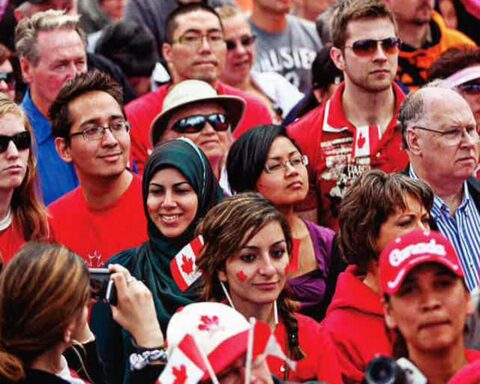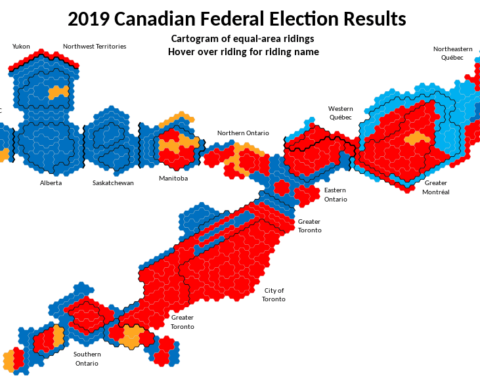This week’s poll numbers drive home the important role debates could play in Campaign 2015. They also point to a tactical bind limiting the expansion prospects of the New Democrat and Liberal vote — and broad support for at least one controversial plank in the Harper Conservatives’ economic strategy.
As the charts show, the race remains locked in a very tight three-way race. The NDP appears to have plateaued, but still hangs on to a slight lead over a pretty moribund Conservative party. The Liberals are showing signs of life and may be closing the gap a little.
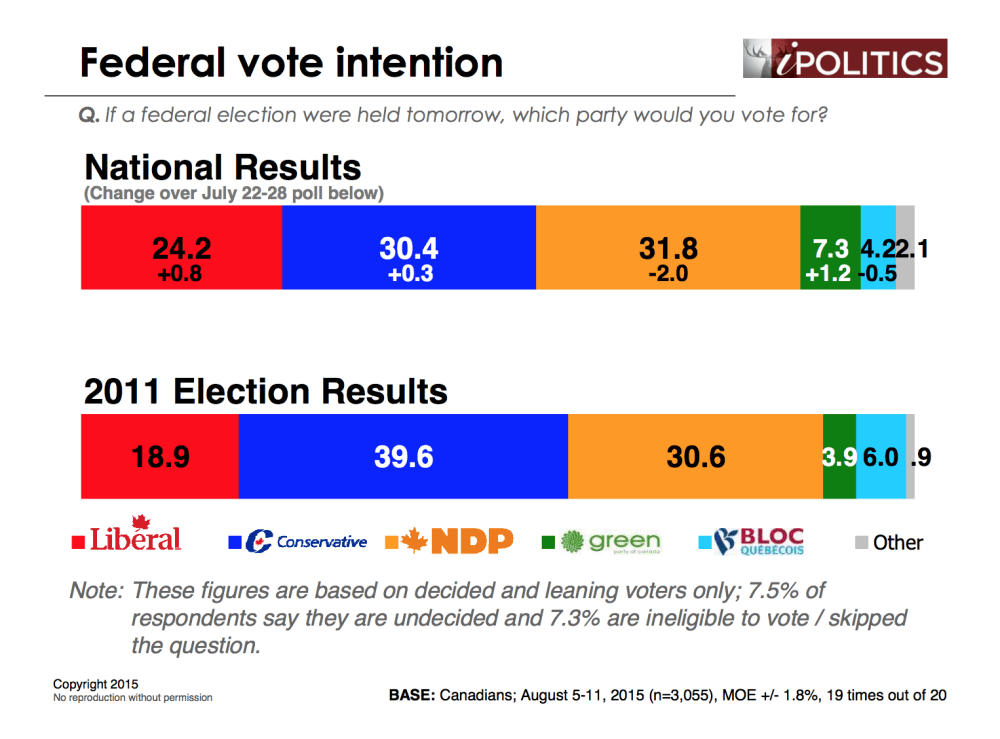 The Maclean’s leaders’ debate did move the dial somewhat, but the effects dissipated as we got further away from the event. The debate’s short term impact seemed to help Justin Trudeau and the Liberals and gave a temporary boost to Elizabeth May and the Green Party. We suspect that it will take more concerted communication and exposure to sustain and build on these effects.
The Maclean’s leaders’ debate did move the dial somewhat, but the effects dissipated as we got further away from the event. The debate’s short term impact seemed to help Justin Trudeau and the Liberals and gave a temporary boost to Elizabeth May and the Green Party. We suspect that it will take more concerted communication and exposure to sustain and build on these effects.
That’s one reason why the future of the debates — particularly the English consortium debate, which was viewed by some 10 million Canadians last time — is so important.
While overall scores for the direction of the federal government and the country are horrible and approaching historical nadirs, the fractures across social class, gender and partisanship may be even more revealing.
The NDP has emerged as the rallying point for those who are extremely disaffected and most committed to change. It may also be the case that the NDP’s blunter, progressive position on Bill C-51 has been an important ingredient in its success.
While only small minorities outside of the Tory base think the government is moving in the right direction, the incidence of satisfaction is twice as high for Liberal and Green supporters as for the NDP. This gap is also reflected in the demographic constituency for the NDP, which has risen on the support of the university educated, women and age cohorts outside of seniors. These are precisely the groups which show the highest disaffection with the government.
The NDP has emerged as the rallying point for those who are extremely disaffected and most committed to change. It may also be the case that the NDP’s blunter, progressive position on Bill C-51 has been an important ingredient in its success. The issue of future debates must therefore be considered with caution in light of these dynamics; the current and available constituency for the NDP is not in tune with the party’s current position on the consortium debate.
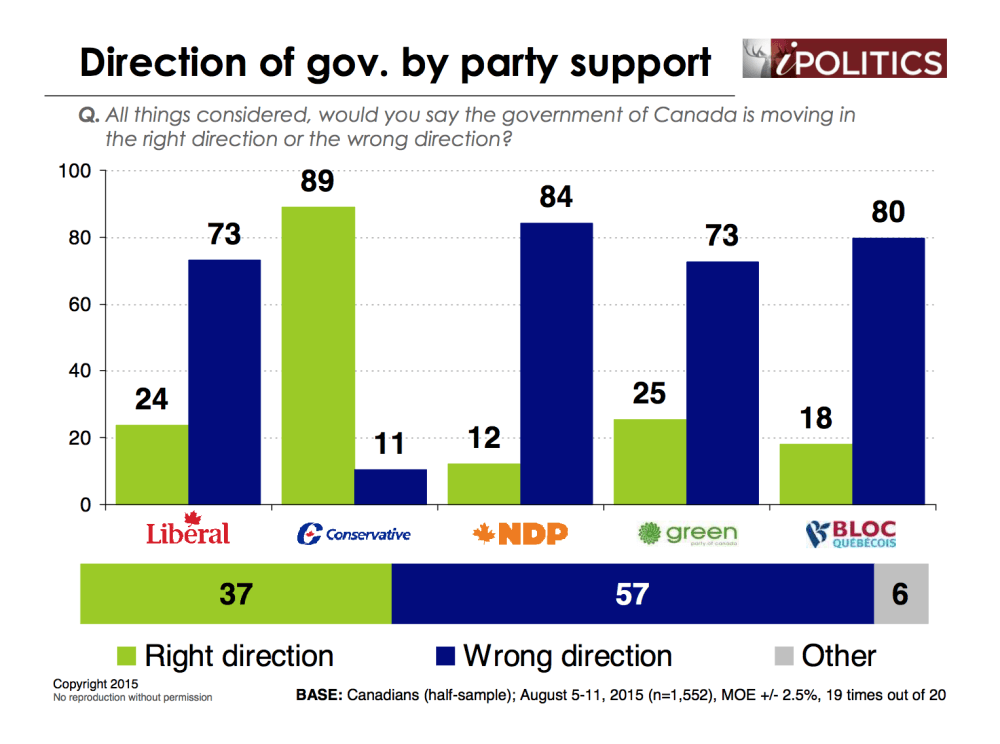 Flip-flopping between NDPs and Liberals
Flip-flopping between NDPs and Liberals
Looking at voters’ expressed second choices, we see a sharp strategic dilemma emerging for both the NDP and the Liberals. The two parties have almost symmetrical second-choice preferences. The NDP’s biggest source of exposure is the Liberal party; the Liberals’ biggest source of exposure is the NDP. Their best opportunities for growth lie in drawing support away from each other.
This week, we asked Canadians for their thoughts on the August 6 leaders’ debate. Long story short: nobody won. Mr. Harper and Mr. Trudeau did well, but the clear winner of the debate was ‘none of the above’.
The voters who are open to supporting either the New Democrats or Liberals make up what we refer to as the ‘promiscuous progressive’ segment. These are voters who are focused on deposing the current government — but are not committed to any one party. They consider a change of government to be job one. Shifting their support back and forth between the NDP and Liberal parties does little to affect the Conservatives’ constituency — and may, because of the vagaries of vote-splitting, reduce the prospects for a change of government.
The political arithmetic is obvious. There is an almost perfect symmetry in these floating voters — roughly 40 per cent of both NDP and Liberal supporters who could switch to the other party. Moving votes from the Liberal to NDP column, or the other way around, still leaves the Conservative vote intact.
Even though potential Conservative defectors make up a much smaller pool, it may be a more worthwhile strategy for the Liberals and New Democrats to work on enticing centre-right voters with a message that change is possible. Roughly 15 per cent of Conservative supporters would consider voting for either the NDP or Liberal party. It’s a smaller pool to fish in, but it does hold open the possibility of narrowing the Conservative vote. This strategic conundrum links in to Canadians’ attitudes toward coalition government — attitudes which are very positive overall (we’ll tell you all about it in next week’s poll).
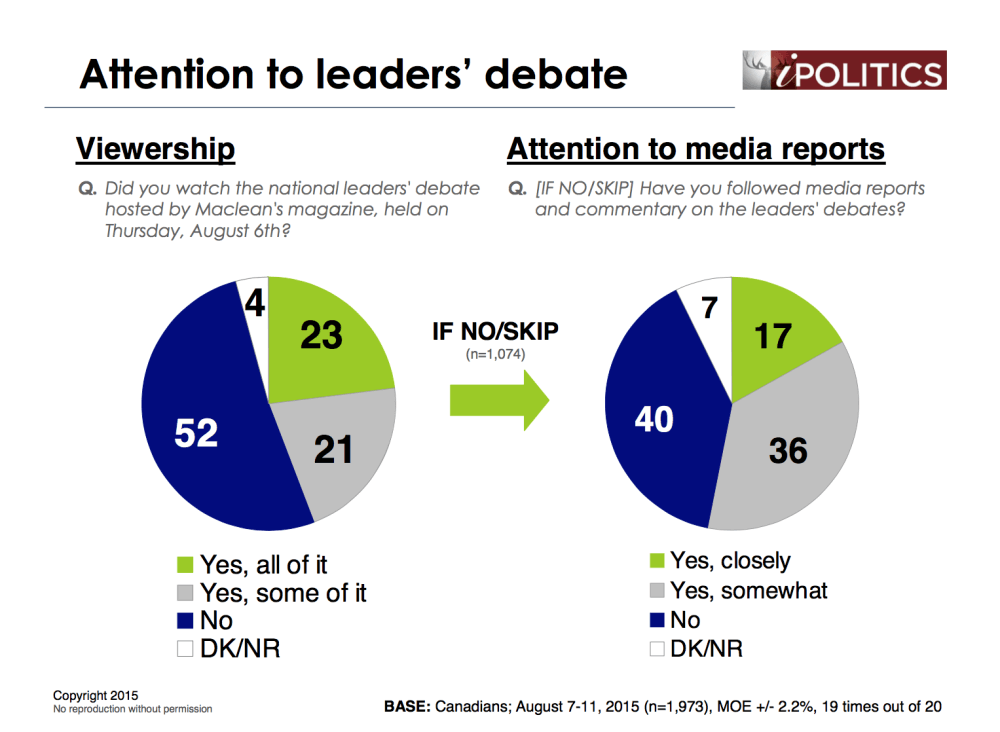 No winners in first leaders’ debate
No winners in first leaders’ debate
This week, we asked Canadians for their thoughts on the August 6 leaders’ debate. Long story short: nobody won. Mr. Harper and Mr. Trudeau did well, but the clear winner of the debate was ‘none of the above’.
On the issue of further debates, we see some interesting results on the question of who should or should not attend.
Clear majorities of Green, NDP and Liberal supporters say all four federalist leaders should be present for all debates. These results suggest that Mr. Mulcair needs to be cautious when it comes to the debate around the debates. He appeals to Canadians because he’s tapping into discontent with the Harper government. In the case of the traditional English-language TV consortium debate, Mulcair does not want to see himself in the same box as Harper — especially given that 81 per cent of his own supporters think he should participate in all the debates.
We understand why the NDP might not want the Green Party present at the debates; the NDP and the Greens are running toe-to-toe in some ridings in British Columbia. But refusing to debate the Green Party would, at best, deny Elizabeth May one to two seats — a generous estimate. Those promiscuous progressives voters are a highly fluid group, so the potential downside to not participating in all debates outweighs the upside.
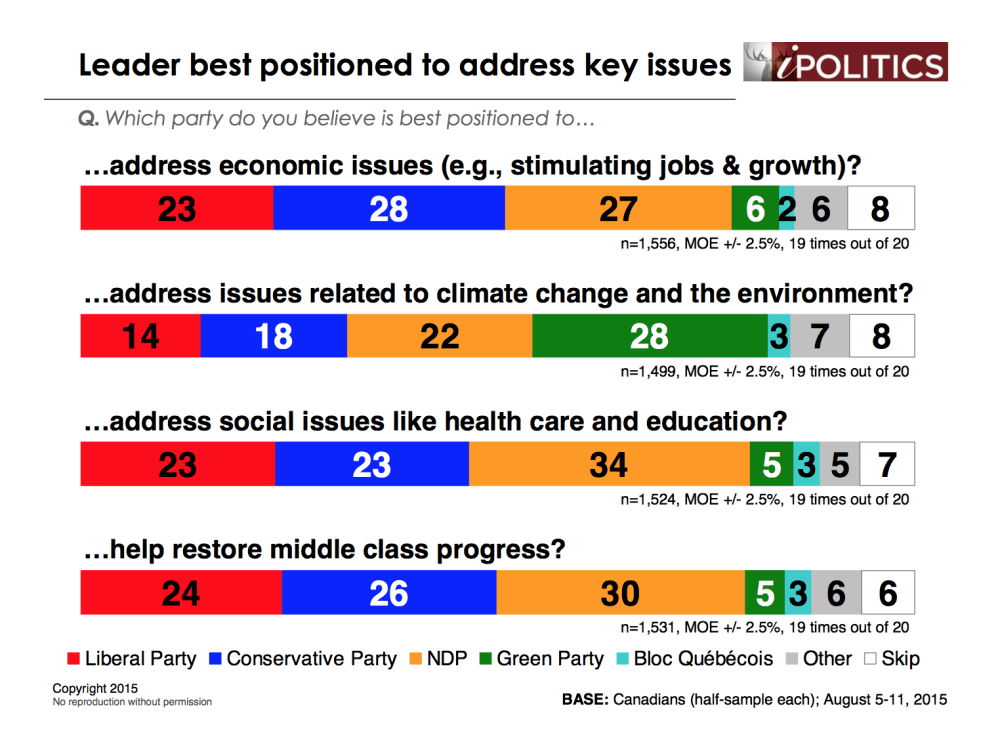 Addressing the issues
Addressing the issues
We also asked Canadians which parties they feel are best poised to address a number of different issues. Looking at what is consistently ranked as the most important election issue — the economy — responses almost perfectly mirror vote intention. Clear majorities believe it is their chosen party that is in the best position to lead the economy (with the exception of Green Party supporters, who would seem to be more comfortable with the NDP taking charge).
Interestingly, the Green Party leads on environmental issues, suggesting that Elizabeth May has done very well in terms of presenting herself as the most committed voice on what has become an orphaned issue. The Liberals are in the hunt on economic and social issues but might want to redress their clear gap on environmental issues — where they’re trailing everyone, including the Conservative party. The NDP has a firm advantage on social issues and holds a slight lead on restoring middle class progress.
[A]s the moral panic associated with the shooting on Parliament Hill and ISIS atrocities fades, so has support for a strengthened security agenda.
Stephen Harper does not have a clear advantage on any of these issues; his best option at this point may to hammer away at issues related to security and terrorism, which generally have worked well for him in the past. But as the moral panic associated with the shooting on Parliament Hill and ISIS atrocities fades, so has support for a strengthened security agenda.
Trade has never been a particularly polarizing issue for Canadians — at least not since the 1990s. Indeed, 8 in ten Canadians support the concept of free trade in North America and a clear majority would support some form of pan-American free trade agreement. The Trans-Pacific Partnership is a special case in that the agreement is still being negotiated and details have not been made public. So voters have been left to speculate on the basis of online rumours — some plausible, some downright silly. The Harper government has done little to address these concerns.
Nevertheless, by a margin of nearly two-to-one, Canadians appear to support the Trans-Pacific Partnership. Support is fairly tepid (43 per cent of Canadians ‘somewhat’ support the agreement), which suggests that many Canadians don’t feel sufficiently informed to take a firm stance one way or the other. The TPP talks are rolling out against a backdrop of softening support for trade liberalization in general, undoubtedly linked to rising economic anxieties. Canadians remain solidly pro-trade but are less enthusiastic than they were in the early days of the century.
Frank Graves is founder and president of EKOS Polling.
Methodology:
This study draws on data from two separate surveys, both of which were conducted using High Definition Interactive Voice Response (HD-IVR™) technology, which allows respondents to enter their preferences by punching the keypad on their phone, rather than telling them to an operator. In an effort to reduce the coverage bias of landline only RDD, we created a dual landline/cell phone RDD sampling frame for this research. As a result, we are able to reach those with a landline and cell phone, as well as cell phone only households and landline only households.
The field dates for the first survey are June 30-July 7, 2015. In total, a random sample of 2,160 Canadian adults aged 18 and over responded to the survey. The margin of error associated with the total sample is +/-2.1 percentage points, 19 times out of 20.
The field dates for second survey are August 5-11, 2015. In total, a random sample of 3,055 Canadian adults aged 18 and over responded to the survey. The margin of error associated with the total sample is +/-1.8 percentage points, 19 times out of 20.
Please note that the margin of error increases when the results are sub-divided (i.e., error margins for sub-groups such as region, sex, age, education). All the data have been statistically weighted by age, gender, region, and educational attainment to ensure the sample’s composition reflects that of the actual population of Canada according to Census data.
Published in partnership with iPolitics.ca.



